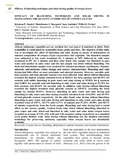| dc.contributor.author | Kirakou, P. Stanley | |
| dc.contributor.author | Hutchinson, J. Margaret | |
| dc.contributor.author | Ambuko, Jane | |
| dc.contributor.author | . Owino, Willis O | |
| dc.date.accessioned | 2017-12-06T06:14:06Z | |
| dc.date.available | 2017-12-06T06:14:06Z | |
| dc.date.issued | 2017 | |
| dc.identifier.citation | KIRAKOU, Stanley P et al. EFFICACY OF BLANCHING TECHNIQUES AND SOLAR DRYING IN MAINTAINING THE QUALITY ATTRIBUTES OF COWPEA LEAVES. African Journal of Horticultural Science, [S.l.], v. 11, p. 18-34, aug. 2017. ISSN 1998-9326. Available at: | en_US |
| dc.identifier.uri | https://profiles.uonbi.ac.ke/mhutchinson/files/kirakaou_et_al_2017.pdf | |
| dc.identifier.uri | http://hdl.handle.net/11295/101624 | |
| dc.description.abstract | African indigenous vegetables are an excellent low cost source of nutrients in diets. Their availability is constrained by seasonality hence peaks and lows. The objective of this study was to investigate the effect of blanching and solar drying as means of dehydration on nutrient composition of cowpea (Vigna unguiculata) leaf vegetable. The blanched samples were subjected to hot water treatment for 2 minutes at 940C followed by cold water treatment at 80C for 2 minutes and then solar dried. One sample was blanched in pure water and another in salty water and the last sample was dried without blanching. The fresh and dehydrated samples were analyzed for selected proximate constituents, vitamins, minerals, anti-nutrients, colour change and sensory characteristics. Blanching and solar drying had little effect on most proximate and mineral elements. However, ascorbic acid, beta carotene and total phenolic content were most affected. Solar dried without blanching recorded the highest vitamin retention levels at 68.02% for beta carotene and 68.39% for ascorbic acid unlike blanching in pure water and solar drying at 55.58% for β_carotene and 21.08% for ascorbic acid and blanching in salty water and solar drying at 52.78% for beta carotene and 20.24% for ascorbic acid. In addition, solar drying without blanching recorded the highest retention total phenolic content at 149.91% exceeding the fresh sample by around 49.91%. However, blanching in pure water and solar drying and blanching in salty water and solar drying recorded retention levels of 62.58% and 65.79% of total phenolic content respectively. On the other hand, solar drying without blanching, blanching in pure water and solar drying and blanching in salty water and solar drying recorded a loss of 5.87%, 10.77% and 11.17% of oxalates and 37.22%, 69.98% and 58.7% of nitrates respectively from the fresh sample. Blanching and solar drying had a varied effect on the sensory quality. Cooked fresh, solar dried without blanching, blanched in pure water and solar dried and blanched in salty water and solar dried cowpea leaves recorded an average of 5.91, 4.91, 4.46 and 3.46 consumer rating respectively on a standard seven points hedonic scale. Solar drying without blanching was the simplest convenient technology for preserving nutrients, especially when cowpea leaves are abundantly available. | en_US |
| dc.language.iso | en | en_US |
| dc.publisher | University of Nairobi | en_US |
| dc.rights | Attribution-NonCommercial-NoDerivs 3.0 United States | * |
| dc.rights.uri | http://creativecommons.org/licenses/by-nc-nd/3.0/us/ | * |
| dc.title | Efficacy of blanching techniques and solar drying in maintaining the quality attributes of Cowpea leaves | en_US |
| dc.type | Article | en_US |



